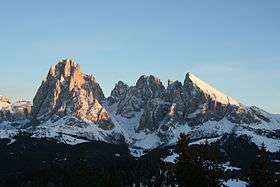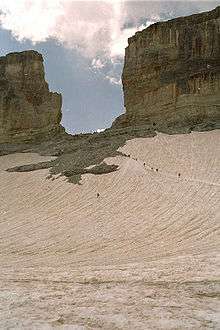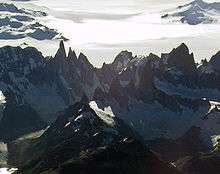Col



In geomorphology, a col is the lowest point on a mountain ridge between two peaks.[1] It may also be called a notch, a gap or a saddle,[1] although the last-named usually has a wider meaning and may contain a mountain pass. Moreover, the term col tends to be associated more with mountain, rather than hill, ranges.[2]
The height of a summit above its highest col (called the key col) is effectively a measure of a mountain's prominence, an important measure of the independence of its summit. Cols lie on the line of the watershed between two mountains, often on a prominent ridge or arête.
Particularly rugged and forbidding cols in the terrain are usually referred to as notches. They are generally unsuitable as mountain passes, but are occasionally crossed by mule tracks or climbers' routes.
For example, the highest col in Austria, the Obere Glocknerscharte ("Upper Glockner Col", 3,766 m (AA)), lies between the Kleinglockner (3,783 m (AA)) and Großglockner (3,798 m (AA)) mountains, giving the Kleinglockner a minimum prominence of 17 metres. The notch is about 8 metres wide and links the two peaks with a usually corniced, often only two foot wide, narrow, snow-covered ridge. The col is on the normal climbing route from the Adlersruhe to the summit of the Großglockner; it acts as the exit from the Pallavicini Couloir (Pallavicini-Rinne) (an ice gully lying at up to 55 ° to the horizontal) from the north and has never been climbed from the south. Hardly anyone has ever considered crossing the Glockner massif via this col.[3]
The overwhelming majority of cols are, however, unnamed and are either never transited or only crossed in the course of negotiating a ridge line. For example, every Gratturm ("ridge pinnacle", e.g. the Gendarm) has a col. Many double summits are separated by prominent cols. The number of cols gave rise to the name of the Lyskamm (Lauskamm).
The distinction with other names for breaks in mountain ridges such as saddle, wind gap or notch is not sharply defined and may vary from place to place.
Other well-known cols are:
- South Col between Mount Everest and Lhotse
- Langkofel Col (Langkofelscharte) in the Langkofel Group
- Kopské Col (Kopské sedlo) between High Tatras and Belianske Tatras
- The notches of the Peuterey ridge on Mont Blanc
- Hohe Dachsteinscharte (2,874 m (AA)) between the Hoher and Niederer Dachstein.
- the cols between the five points above 4,000 metres on the ridge of Teufelsgrat on the Mont Blanc du Tacul
- Brèche de Roland in the Pyrenees
See also
References
- 1 2 Whittow, John (1984). Dictionary of Physical Geography. London: Penguin, 1984, p. 103. ISBN 0-14-051094-X.
- ↑ Chambers 21st Century Dictionary, Allied.
- ↑ Willi End, Hubert Peterka: Alpenvereinsführer Glockner- und Granatspitzgruppe, Bergverlag Rudolf Rother, Munich, 1990. ISBN 3-7633-1258-7
External links
| Look up col in Wiktionary, the free dictionary. |
| Wikimedia Commons has media related to Col. |
Illustrated Glossary of Alpine Mountain Landforms: Col. Retrieved 16 August 2015.